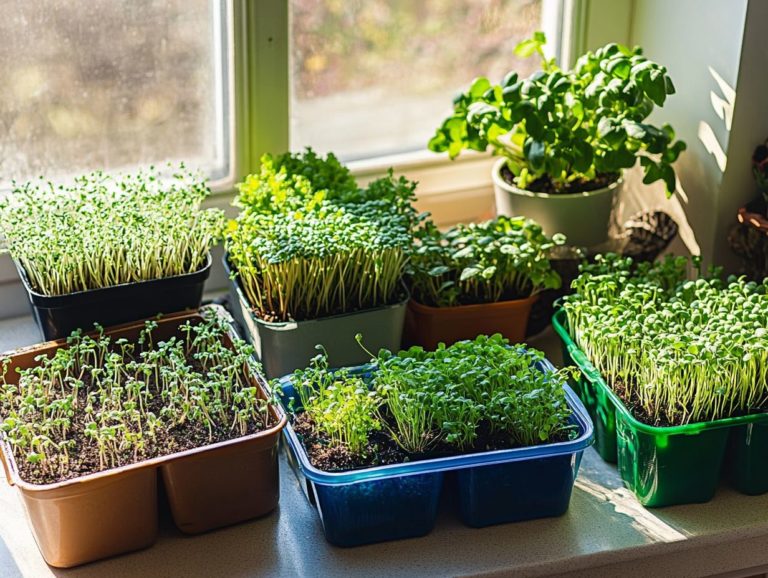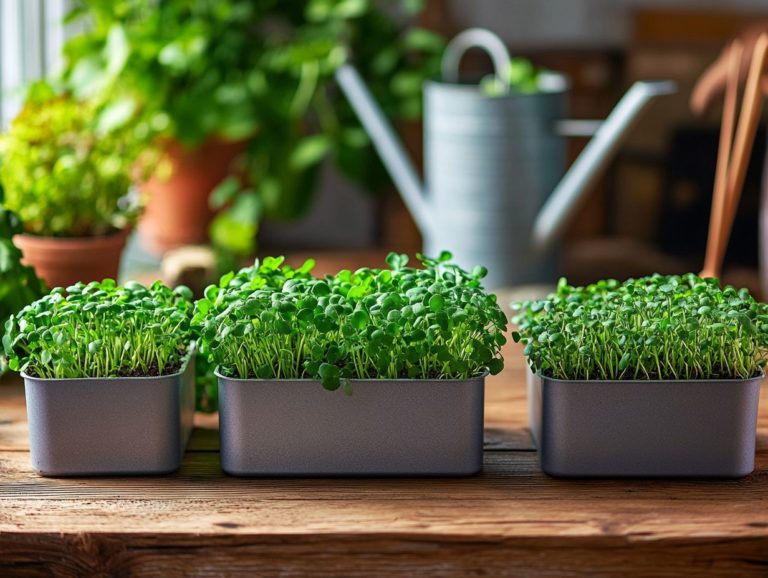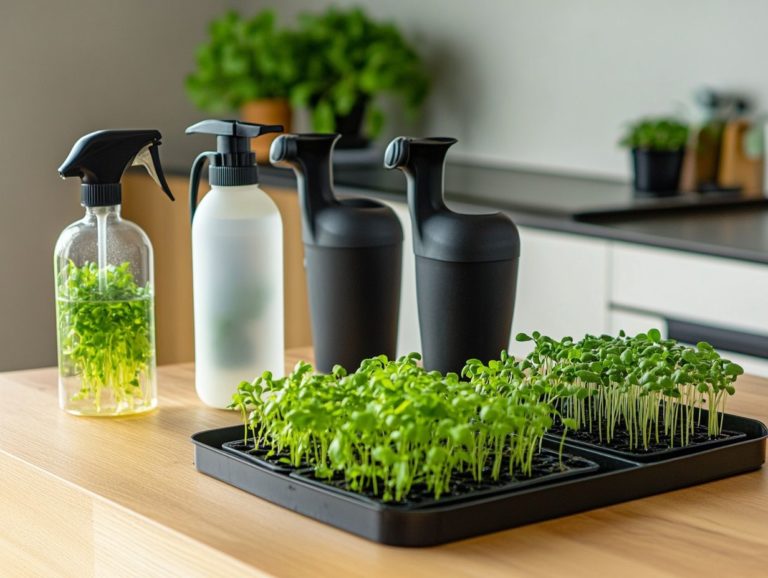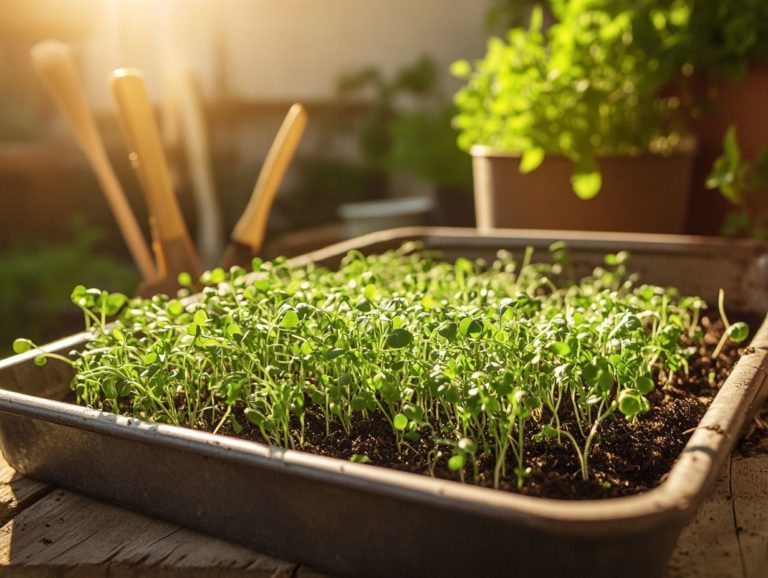How to Organize Your Microgreen Supplies
Microgreens are small yet powerful, brimming with flavor and nutrients. They ve captured the hearts of health enthusiasts and culinary creators alike. Grown from microgreen seeds, they offer a sustainable choice for any urban gardener.
If you re keen on growing your own, having the right supplies is crucial. This guide will provide you with everything necessary, from essential tools to effective storage solutions, including the best planting trays and growing media.
You ll discover how to develop a thoughtful growing schedule, steer clear of common pitfalls, and maintain a sustainable supply. Get ready to transform your home gardening game!
Contents
- Key Takeaways:
- What are Microgreens?
- Supplies Needed for Growing Microgreens
- Organizing Your Microgreen Supplies
- Creating a Growing Schedule
- Common Mistakes to Avoid
- Essential Tips for a Sustainable Microgreen Supply!
- Frequently Asked Questions
- How do I organize my microgreen supplies?
- What are the essential supplies needed for growing microgreens?
- How can I make my microgreen supplies easily accessible?
- Should I label my microgreen supplies?
- How often should I clean and organize my microgreen supplies?
- Tips for Organizing Your Microgreen Supplies
Key Takeaways:
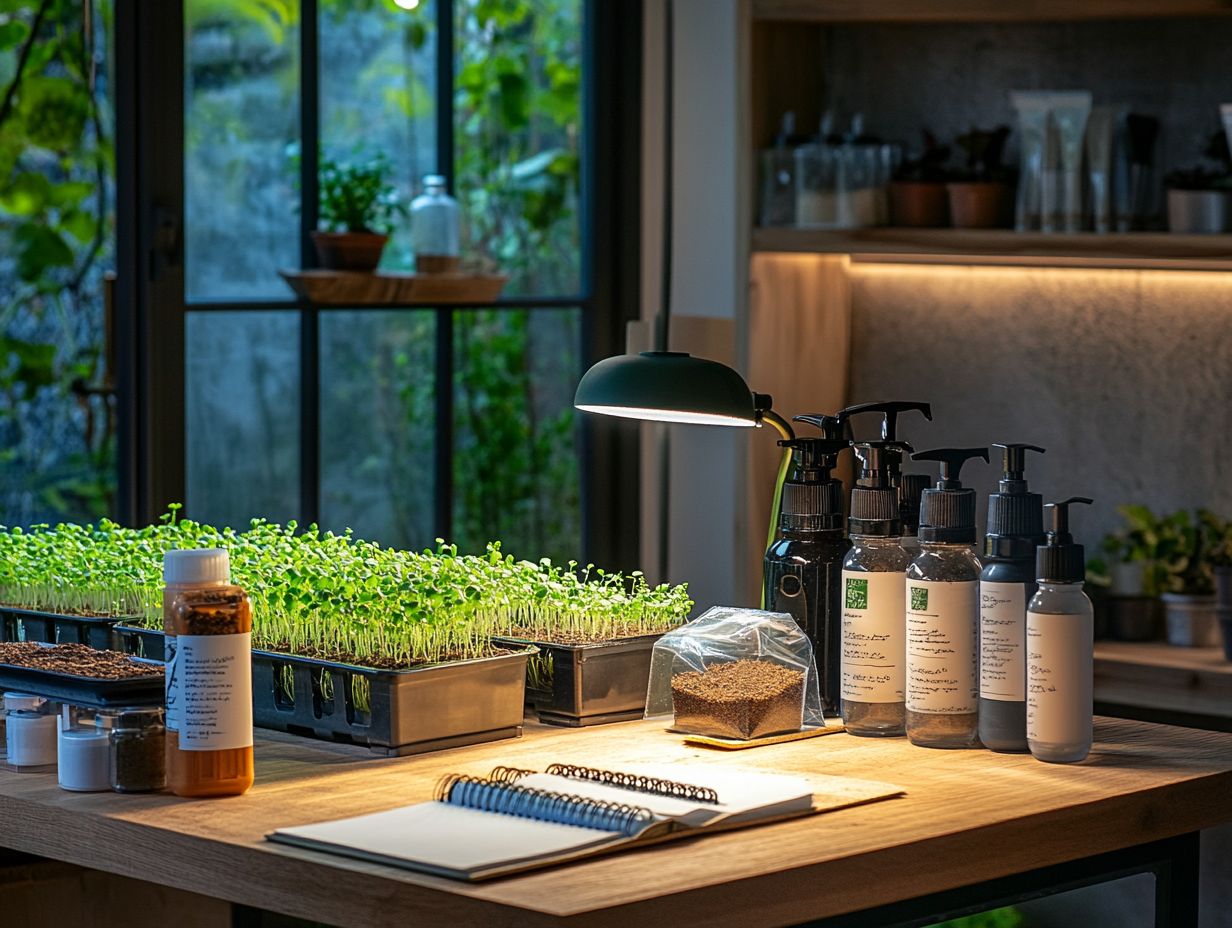
- Keep your microgreen supplies organized by designating a specific storage area and using containers or shelves to categorize and store materials.
- Create a growing schedule to optimize the growth and harvesting times of your microgreens, ensuring a consistent and plentiful supply.
- Help maintain a sustainable supply of microgreens by reusing and recycling materials, such as growing trays and coconut coir, to reduce waste and cost.
What are Microgreens?
Microgreens are young, edible plants harvested at their peak of freshness, brimming with flavor, nutrients, and stunning colors. These delightful miniature greens think Amaranth, Arugula, Broccoli, Brussels Sprout, and Cabbage have captured the hearts of urban gardeners and health enthusiasts alike.
Grown from microgreen seeds, they can thrive both indoors and outdoors. This makes them an ideal choice for home gardening, especially in cozy urban spaces where every inch counts. With their rapid germination and quick harvest times, you can enjoy a continuous supply of fresh greens, making them a truly sustainable addition to any kitchen.
Supplies Needed for Growing Microgreens
To successfully grow microgreens, you ll need a few essential supplies, such as microgreen seeds, suitable growing media, and effective planting trays.
The choice of growing media significantly influences the germination and growth of your microgreens. Popular options include coconut coir and seed starting mixes.
If you want to try growing plants in water instead of soil, selecting the right hydroponic nutrients becomes crucial for achieving optimal growth.
Make sure you have the right soil volume and utilize well-structured growing trays. This will greatly contribute to a healthy microgreen yield. Being well-equipped is essential for any urban gardener looking to thrive in this rewarding endeavor.
Essential Tools and Materials
Essential tools and materials for cultivating microgreens include premium microgreen seeds, high-quality planting trays, and blackout domes designed to optimize the germination process. Selecting appropriate growing trays that ensure adequate drainage and support is vital. Choosing the right hydroponic nutrients can significantly enhance your microgreens’ growth.
These elements work harmoniously to establish an ideal environment for your plants, promoting robust development from seed to harvest.
The blackout domes mimic dark and humid conditions, accelerating sprouting and seedling establishment. When utilizing these domes, ensure they fit snugly over the planting trays to trap moisture while avoiding waterlogging.
Monitor humidity levels; removing the dome once the seeds have germinated is essential for proper air circulation and light exposure key factors for healthy photosynthesis.
Opting for biodegradable trays not only supports sustainability but also enhances the root environment, facilitating efficient growth and seamless transplanting when the time is right.
Start your microgreen journey today and enjoy fresh greens at home!
Organizing Your Microgreen Supplies

Organizing your microgreen supplies with precision is essential for any urban gardener who wants to make growing easier and commit to sustainable home gardening.
This involves categorizing your essential items, such as growing media, different microgreen varieties, and tools, so they are easily accessible.
By using effective storage solutions, you ll not only save time but also minimize clutter, making your gardening experience more enjoyable and productive.
Storage Solutions and Tips
Effective storage solutions for your microgreen supplies are crucial for maintaining the quality of your growing media, seeds, and nutrients. By choosing appropriate containers that protect these essentials from moisture and pests, you can significantly extend their shelf life.
Organizing your supplies improves accessibility and creates an ideal environment for successful home gardening.
Airtight containers are essential for storing seeds as they prevent humidity from compromising their viability. Using separate bins for different types of organic growing media allows for better management and helps prevent cross-contamination. If you’re interested in growing microgreens, check out this guide on how to start a microgreen garden for beginners.
A labeling system helps you quickly identify each item and its expiration date. Creating an inventory will assist you in tracking your supplies, reducing waste and the risk of running low when you’re eager to sow your next batch.
These practices streamline your gardening process and instill confidence in your home gardening endeavors.
Creating a Growing Schedule
Establishing a growing schedule is essential for urban gardeners looking to boost their microgreen production. This schedule is a valuable tool for tracking germination and harvest times for various microgreen varieties.
With a solid plan in place, you can coordinate planting and harvesting cycles, ensuring a steady supply of fresh microgreens year-round.
By understanding the specific germination and harvest timelines of different microgreens, you can optimize your growing media usage and maximize your yield. Additionally, learning how to use grow lights for microgreens can further enhance your growing success.
Optimizing Growth and Harvesting Times
To truly optimize your microgreens’ growth and harvesting times, grasp the intricacies of germination time and the application of hydroponic nutrients. Each microgreen variety has its distinct growth cycle, and using nutrients effectively can accelerate plant development.
By closely monitoring these factors, you’ll ensure timely harvests, providing a consistent supply of fresh greens for your culinary adventures.
Tailoring nutrient concentrations to the specific microgreen you re cultivating is key; some varieties thrive on higher nitrogen levels, while others prefer a more balanced mix.
Additionally, fine-tuning environmental conditions like light intensity, humidity, and temperature will meet each type’s specific needs.
Keeping detailed records of germination and harvest times helps evaluate growth rates and enhance future planting strategies. This thoughtful approach yields optimal results, maximizing your investment of effort and resources in your microgreen garden. For those interested in innovative methods, learning How to Use Hydroponics for Microgreens can further improve your gardening success.
Common Mistakes to Avoid
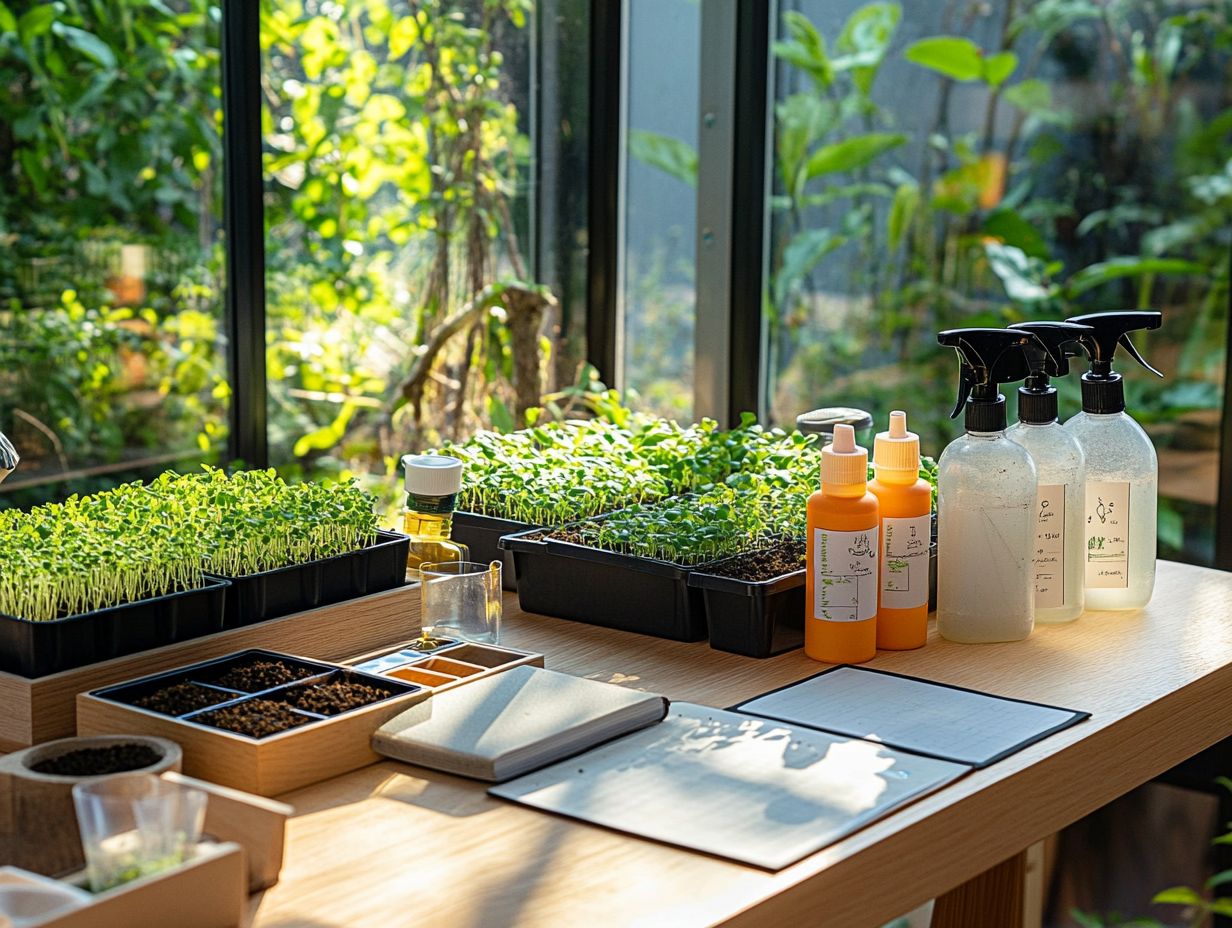
Avoiding common mistakes makes your gardening journey easier and more enjoyable! Steering clear of improper seed selection, inadequate growing media, and mismanagement of hydroponic nutrients can save you from frustration and wasted resources.
By recognizing these prevalent errors, you can enhance your gardening skills, resulting in healthier microgreens and a more gratifying growing experience.
Troubleshooting and Preventing Issues
Troubleshooting and preventing issues in microgreen cultivation can dramatically enhance your outcomes. This ensures that your microgreen seeds flourish from germination to harvest.
Early identification of distress signals is vital for a successful crop. For instance, if you notice slow or uneven growth, adjust your light exposure or check the moisture levels in your growing medium.
Using a tool to measure temperature and humidity allows you to effectively monitor these essential environmental factors. Conduct regular inspections for pests and diseases as they serve as your first line of defense against potential infestations.
Establish a consistent schedule for watering and nutrient application to promote healthy growth and reduce the risk of mold, which tends to thrive in overly damp conditions.
Stay informed about best practices to address any challenges proactively, ultimately ensuring a bountiful harvest.
Essential Tips for a Sustainable Microgreen Supply!
Maintaining a sustainable supply of microgreens is crucial for any urban gardener eager to reduce waste and embrace environmentally friendly practices.
This journey involves selecting the right microgreen varieties and implementing effective strategies for reusing and recycling cultivation materials. By adopting these sustainable methods, you can easily enjoy a continuous supply of fresh greens while minimizing your ecological footprint! For more tips, check out this step-by-step guide to sowing microgreens.
Reusing and Recycling Materials
Reusing and recycling materials in your microgreen gardening not only reflects a commitment to sustainability but also enhances the efficiency of your growing experience. By repurposing items like planting trays and containers for hydroponic nutrients, you can effectively reduce waste while saving on gardening costs.
For example, yogurt cups make excellent seed starters, and old glass jars can be transformed into mini-greenhouses that maintain optimal humidity for seed germination. Even cardboard egg cartons can hold soil and seeds, creating a nurturing environment for your young microgreens! To learn more about the best containers for microgreen cultivation, check out The Best Containers for Microgreen Cultivation.
These inventive repurposing ideas divert waste from landfills and lead to significant financial savings. Buying new containers can add up quickly! Embracing such innovative practices nurtures the planet while enriching your gardening journey, making it fulfilling and eco-conscious.
Frequently Asked Questions
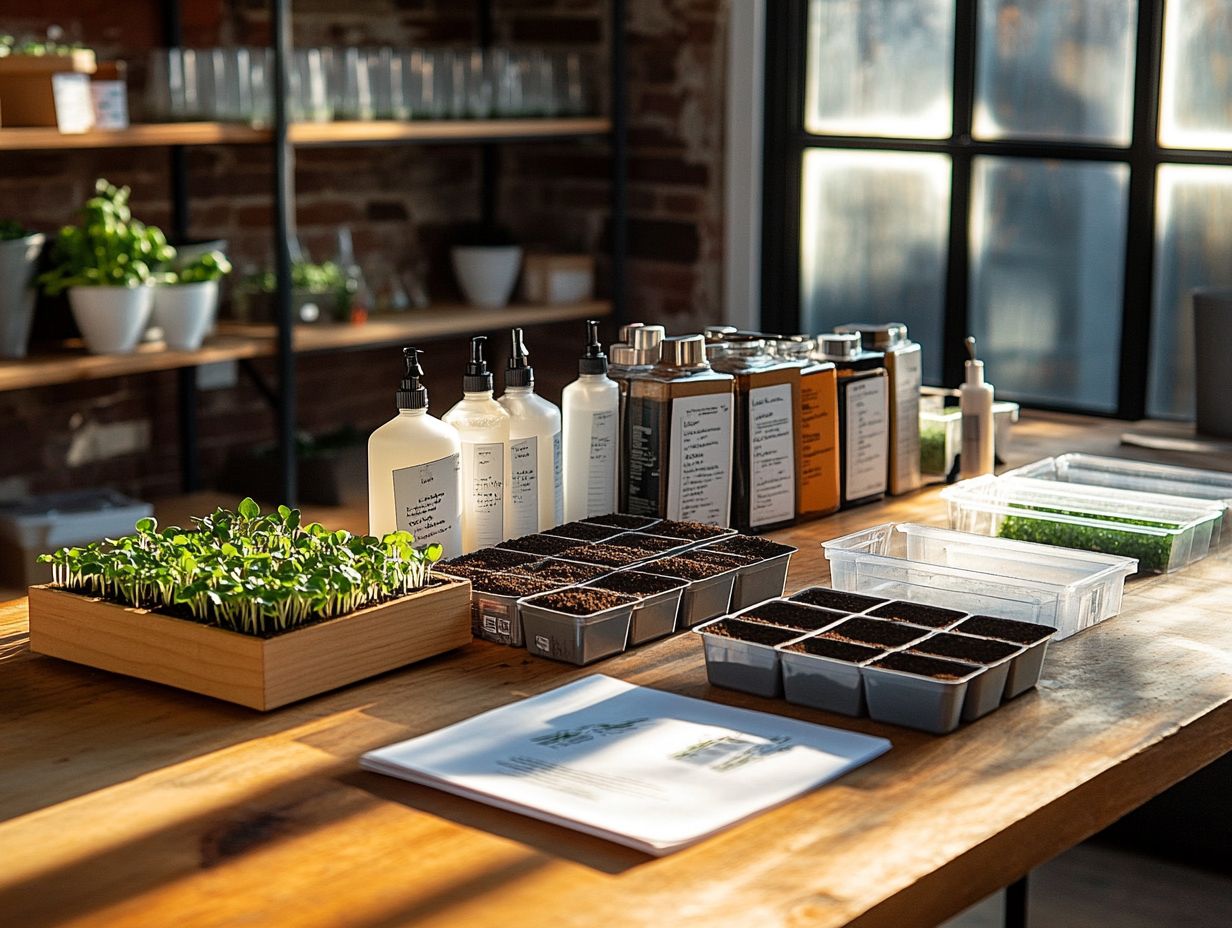
How do I organize my microgreen supplies?
To organize your microgreen supplies, gather all your materials in one place. Sort them into categories such as seeds, soil, trays, and tools. Use storage containers or shelves to keep everything organized and label them for easy identification.
What are the essential supplies needed for growing microgreens?
The essential supplies for growing microgreens include seeds, soil, trays, water, and a light source. You may also need basic gardening tools like scissors, a spray bottle, and a measuring cup.
How can I make my microgreen supplies easily accessible?
To make your microgreen supplies easily accessible, create a designated growing area in your home. This could be a corner of your kitchen or a shelf in your living room. Use hanging shelves or wall-mounted racks to keep your supplies within reach and save space!
Should I label my microgreen supplies?
Labeling your microgreen supplies is highly recommended! It helps you quickly find what you need and prevents confusion when using different types of seeds or soil. Use labels or markers to mark your containers or shelves.
How often should I clean and organize my microgreen supplies?
It’s best to clean and organize your microgreen supplies after every use. This ensures that your materials are in good condition and ready for the next growing cycle. Check for any damaged or expired supplies and replace them as needed.
Start your microgreen journey today! Explore more resources and consider joining a community of fellow urban gardeners to share tips and experiences.
Tips for Organizing Your Microgreen Supplies
Keeping your microgreen supplies organized is essential for efficiency. Start by decluttering your space regularly this means removing any items you no longer need.
After each use, store your supplies properly. It s also a good idea to keep a list of what needs to be restocked.
Assign a specific spot for each type of supply. This way, you’ll always know where to find everything!


